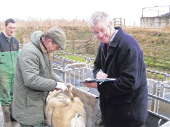Fed Up With Footrot?
1 June 2016 When the weather warms up and more ewes are seen limping the cause is usually due to infection with footrot organisms that are temperature sensitive. Often it is the same ewes that were treated last year. Keeping a note of sheep treated for footrot is a quality assurance regulation and can be achieved using either EID or by notching tags. Culling repeated offenders because they act as a reservoir of disease is an effective method of reducing the incidence.
When the weather warms up and more ewes are seen limping the cause is usually due to infection with footrot organisms that are temperature sensitive. Often it is the same ewes that were treated last year. Keeping a note of sheep treated for footrot is a quality assurance regulation and can be achieved using either EID or by notching tags. Culling repeated offenders because they act as a reservoir of disease is an effective method of reducing the incidence.
In the past regular foot trimming and spot treatment of lame sheep with antibiotics was the formula most farmers used, but this has been found to be wanting and regular foot trimming is no longer recommended. Continuing with a treatment regime that’s not working is not a good idea but don’t just give up, try this, it might just work
- At marking or shearing check ewe’s feet and identify those with really bad problem granulomas, misshapen feet, etc. Mark for culling as soon as possible.
- Vaccinate the ewes in mid summer (and again 6 months later prior to housing), this helps to reduce the size of the problem to something your pens can cope with. Many wet farms have significant footrot problems that are difficult to treat when pens are muddy and large numbers of sheep need to be brought in.
- The essential point in controlling footrot is that ewes need to stand for an hour on dry concrete after foot bathing.
- Reduce spread of the disease using builders lime around troughs and feeders and in lambing pens.( Important safety note – builders lime, if it gets in your eyes will cause permanent blindness-take sensible precautions (goggles +,eyewash available)
- Move fast to control scald in lambs, as soon as you see it put lambs through a 2 – 3% formaldehyde solution, which is 200 – 300 ml of formaldehyde (40% solution) in 10 litres of water.
- After treatment stand on concrete for an hour.
- Restrict foot trimming to only known causes, to identify the lesion or to tidy up after antibiotic treatment has worked.
In April 2015 formaldehyde was reclassified by the EU as carcinogen category 1B and mutagenic category 2, resulting in relabelling of products. This may restrict its use in the future, but it looks like it should still be available for use in footbaths as a biocide (it is not an approved veterinary medicine), provided one or more UK suppliers become registered. QMS have a very useful online booklet on lameness with really good pictures that help identify the varying conditions that cause lameness, if you are not sure if it’s footrot causing lameness, consult it.
John Vipond
Sign up to the FAS newsletter
Receive updates on news, events and publications from Scotland’s Farm Advisory Service
